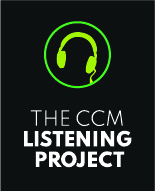Listening is not a binary activity, something you’re either doing or not. There are degrees. There’s “passive” listening — that “in one ear and out the other” state in which you hear sounds but don’t fully process them.
And then there’s active listening, which Christy Thomas of the Yale Center for Teaching and Learning defines as “listening with a purpose.” Thomas also describes it as an ability to  “observe with our ears.” For a musician, active listening is a skill that can be as important as the ability to read notes. Accordingly, it should be a part of every music student’s practice regimen. At CCM, we’re shining a spotlight on the skill of active listening with the CCM Listening Project.
“observe with our ears.” For a musician, active listening is a skill that can be as important as the ability to read notes. Accordingly, it should be a part of every music student’s practice regimen. At CCM, we’re shining a spotlight on the skill of active listening with the CCM Listening Project.
Advice Worth Listening To
The 21st century is an incredible time to be a musician. Technology has not only made it easier than ever to access music of every type from around the world, but also to take our favorite recorded music with us wherever we go. But as Eric O’Donnell notes on jazzadvice.com, “Technology has also had a role in our declining listening habits. … Portable music players inadvertently turn the important recordings in your collection into the background music for your life.”
It’s important, therefore, to set aside time for active listening, which could also be called  intentional listening. O’Donnell points out that listening with intent can help students get a better understanding of abstract theories or concepts. “Instead of learning from definitions and vague descriptions,” he writes, “put on a record and you’ll hear the sound of these devices in action. … Your understanding of fundamental concepts starts with listening to great recordings or live performances: ingraining solid time, a good sound, phrasing, feel, articulation, harmonic tension and release.”
intentional listening. O’Donnell points out that listening with intent can help students get a better understanding of abstract theories or concepts. “Instead of learning from definitions and vague descriptions,” he writes, “put on a record and you’ll hear the sound of these devices in action. … Your understanding of fundamental concepts starts with listening to great recordings or live performances: ingraining solid time, a good sound, phrasing, feel, articulation, harmonic tension and release.”
Becoming an Active Listener
OK, so you recognize the importance of becoming an active listener. Now how do you put it onto practice? MasterClass offers tips on different exercises for developing active listening skills, ranging from consciously trying to pinpoint the structure in a composition (“In classical music, try to identify formal structures, such as a fugue, a sonata form, or a dance style like a rondo or mazurka”) to interpreting song lyrics (“Focus on imagery, figurative language, and rhyme scheme”).
And if you’re unable to identify a structure or catch a lyric on your first attempt at active listening, try again. “Listen more than once or twice to ingrain all the subtleties of that musical information,” O’Donnell writes.
In other words, active listening, like any other aspect of a good music education, takes practice. “Listening isn’t a static activity that stays the same for the rest of your life,” O’Donnell writes. “It’s a skill that can be developed and improved on a daily basis. If you’re a musician, listening is how you take in information whether you’re in the practice room or on stage performing. The more adept you are at collecting this information, the easier you’ll be able to navigate any musical situation.”
That navigational ability is a hallmark of a professional. “You can easily tell how much listening a musician has done through how much they know about the music,” O’Donnell writes, “so make sure you’re not left behind.”
A Skill to Learn for Life
One of the many benefits of sharpening you active listening skills as a musician is that they translate into other situations. Yale’s Christy Thomas notes, for example, that active listening skills can help students get a better understanding of a particular period in history through listening to songs associated with that era.
Or, she adds, “An English course might examine how particular texts have been set to music … An art history course on Impressionism might examine various musical compositions in conjunction with visual works of art of the same period.”
Good active listening skills can even help in situations that don’t involve music at all. As Thomas writes: “The practice of active listening cultivates transferrable skills for how to listen carefully and critically in other situations both inside and outside the classroom—listening to lectures, to political speeches, to TED talks, and even to one another.”
Hear, hear!
Want to start developing your active listening skills today?
There’s no better way than through the CCM Listening Project.
Each month, CCM faculty member Stephen Marotto shares a fascinating playlist, which can be found on either YouTube or Spotify. He gives some background information on all the songs for the month and provides questions to help you think about while you’re listening to the music. The playlists may include songs from a selected topic or genre and have pieces geared for adults as well as our younger learners. It’s a great way for musicians of any age to sharpen their skills while having fun.
Back To Top